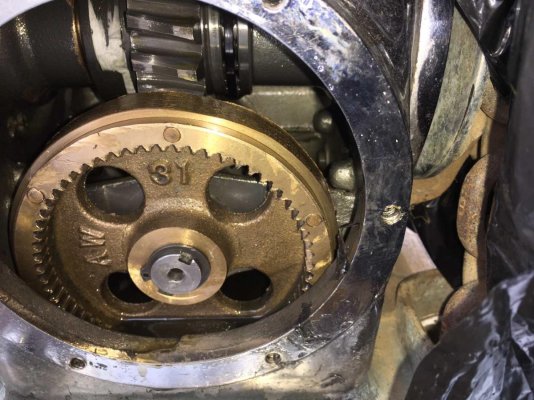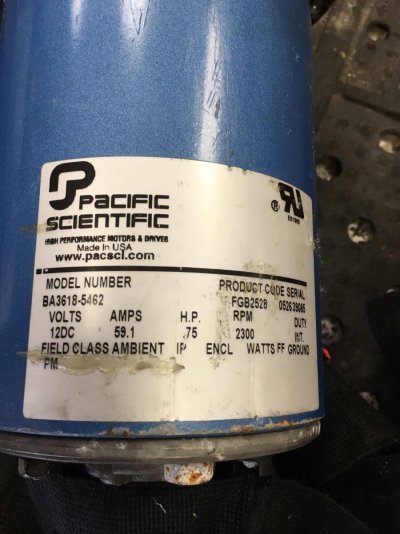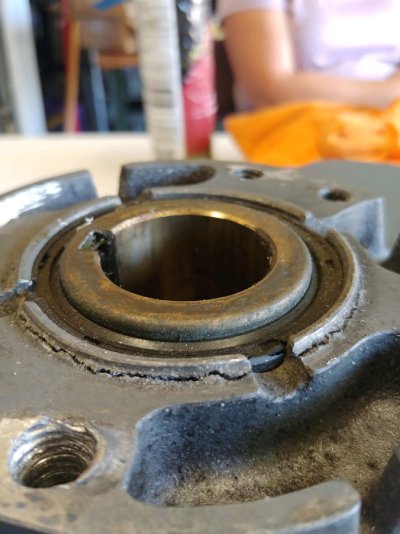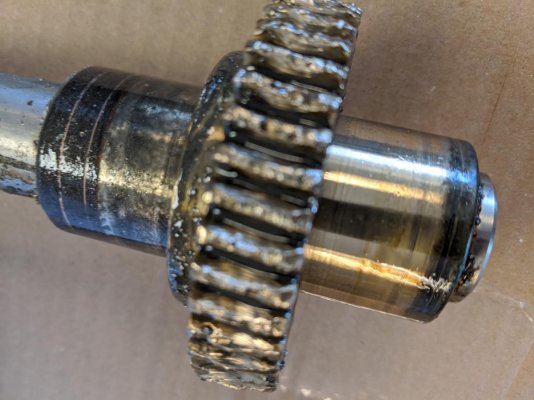JDCAVE
Guru
- Joined
- Apr 3, 2011
- Messages
- 2,902
- Location
- Canada
- Vessel Name
- Phoenix Hunter
- Vessel Make
- Kadey Krogen 42 (1985)
The windlass was always a black box. It looks strong and beefy and it could easily haul a 35 kg anchor and a vertical height of 100’ of 3/8 BBB chain so we thought it was indestructible. Not so! One day it failed, fortunately only in 30’ of water so I was able to haul up the anchor and chain with some effort. As the Genny, the Webasto had already failed and the fish finder transducer was failing, we decided there were too many projects to contemplate remotely so we came home early.
The windlass has been a project that would have been impossible for me without the friendly neighbourhood machinist. With the border closed, a trip to Plath was out of the question. So we removed the winch motor housing and tested the winch motor. It would not run. A trip to Brighouse Electric and $275 later it ran. Brighouse determines that corrosion was In part responsible and examination of the winch housing revealed a plimsoll line indicating standing water in the housing. We have now drilled a drain port At the lowest point in the housing with a plug that will allow regular draining. I may leave that port open. Not sure yet.
Here were a lot of trips to and from the boat. That was because I wanted to leave the windlass case in place on the boat to avoid rebedding same.
However, the machinist was concerned with the wear on the two gears: a steel gear on the winch motor which engages with a bronze planetary gear. For those unaware, a windlass has two shafts. Or at least mine does. There is a shaft that transfers motion from the winch motor (2300 rpm) to another, perpendicular shaft that holds the wild cat and capstan. Obviously the rpm of the winch motor is reduced to a speed of the turning windlass. There are two bearings and a bronze planetary gear on the 1st shaft and a worm gear that engages with the wildcat shaft. We ordered the parts from Plath: the winch gear and planetary gear, 2 bearings and 2 seals. $1200 Cdn after taxes. Dealing with the guy at Plath was not easy. He doesn’t answer his phone and is very slow to respond to emails. We could not get any kind of advice along with way for the project. Also, the gear for the winch motor was for a 1/2” shaft and my motor had a 5/8” shaft. Fortunately, Jim was able to machine that out.
However the real work began when we discovered someone else had worked on this windlass, and they weren’t kind to it. You need a rod “drift” to tap out these shafts. They should be bronze or brass. Someone had used steel rods for this purpose and they result in slight mushrooming on the ends. This is troublesome when putting the bearings and seals in place. Second, there was a collar on the brake on the wildcat that is keyed. The key was missing and the keyway had widened. Jim had to work through that process. Second: there was a particular “Heavy Duty” snap ring (3/4”) that apparently is a very rare bird. I phoned Suppliers everywhere in the lower mainland including machine shops at Seaspan and Allied Shipyards, as well as Daphoe shafts and no joy. I had to order it in from Grainger and that took another 2 weeks for delivery. Eventually we got it working but it was a very frustrating process.
Lessons learned:
1) Respect your windlass! Only two teeth on the winch gear and the planetary gear are engaged at any time. Bronze is a softer metal than steel. Sudden and “violent” forces can occur at times such as when the Anchor slams onto the pulpit, or if towing. And all those forces are directed onto only two bronze teeth at any time. I think we were unduly hard on it. And always use a snubber. Always! Even when day anchoring but especially when testing holding of the anchor.
2) Check the housing on your winch motor for water. It will kill your winch motor. Oh, and according to Plath you cannot substitute another motor that winch motor. And the outfit that made it is no longer around. The folks at Brighouse disagreed with that.
Planetary Gear. Note wear.

Gear on winch motor:

Manufacturer of winch motor:

The windlass has been a project that would have been impossible for me without the friendly neighbourhood machinist. With the border closed, a trip to Plath was out of the question. So we removed the winch motor housing and tested the winch motor. It would not run. A trip to Brighouse Electric and $275 later it ran. Brighouse determines that corrosion was In part responsible and examination of the winch housing revealed a plimsoll line indicating standing water in the housing. We have now drilled a drain port At the lowest point in the housing with a plug that will allow regular draining. I may leave that port open. Not sure yet.
Here were a lot of trips to and from the boat. That was because I wanted to leave the windlass case in place on the boat to avoid rebedding same.
However, the machinist was concerned with the wear on the two gears: a steel gear on the winch motor which engages with a bronze planetary gear. For those unaware, a windlass has two shafts. Or at least mine does. There is a shaft that transfers motion from the winch motor (2300 rpm) to another, perpendicular shaft that holds the wild cat and capstan. Obviously the rpm of the winch motor is reduced to a speed of the turning windlass. There are two bearings and a bronze planetary gear on the 1st shaft and a worm gear that engages with the wildcat shaft. We ordered the parts from Plath: the winch gear and planetary gear, 2 bearings and 2 seals. $1200 Cdn after taxes. Dealing with the guy at Plath was not easy. He doesn’t answer his phone and is very slow to respond to emails. We could not get any kind of advice along with way for the project. Also, the gear for the winch motor was for a 1/2” shaft and my motor had a 5/8” shaft. Fortunately, Jim was able to machine that out.
However the real work began when we discovered someone else had worked on this windlass, and they weren’t kind to it. You need a rod “drift” to tap out these shafts. They should be bronze or brass. Someone had used steel rods for this purpose and they result in slight mushrooming on the ends. This is troublesome when putting the bearings and seals in place. Second, there was a collar on the brake on the wildcat that is keyed. The key was missing and the keyway had widened. Jim had to work through that process. Second: there was a particular “Heavy Duty” snap ring (3/4”) that apparently is a very rare bird. I phoned Suppliers everywhere in the lower mainland including machine shops at Seaspan and Allied Shipyards, as well as Daphoe shafts and no joy. I had to order it in from Grainger and that took another 2 weeks for delivery. Eventually we got it working but it was a very frustrating process.
Lessons learned:
1) Respect your windlass! Only two teeth on the winch gear and the planetary gear are engaged at any time. Bronze is a softer metal than steel. Sudden and “violent” forces can occur at times such as when the Anchor slams onto the pulpit, or if towing. And all those forces are directed onto only two bronze teeth at any time. I think we were unduly hard on it. And always use a snubber. Always! Even when day anchoring but especially when testing holding of the anchor.
2) Check the housing on your winch motor for water. It will kill your winch motor. Oh, and according to Plath you cannot substitute another motor that winch motor. And the outfit that made it is no longer around. The folks at Brighouse disagreed with that.
Planetary Gear. Note wear.

Gear on winch motor:

Manufacturer of winch motor:

Last edited:







